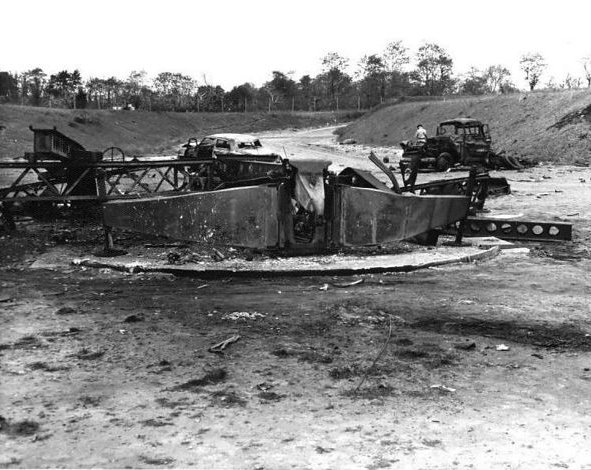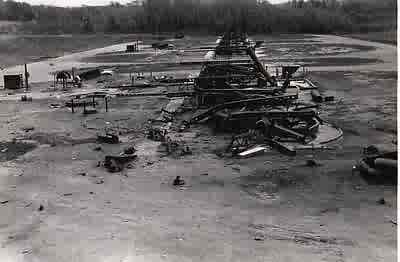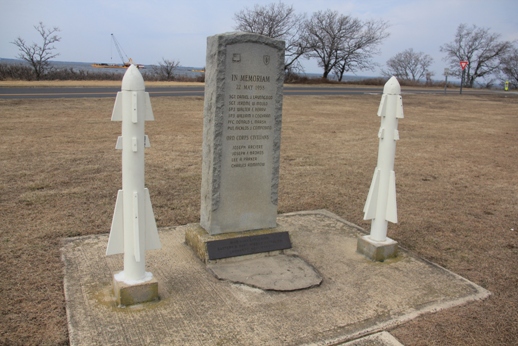On May 22, 1958, a Nike Ajax missile exploded and detonated seven other missiles lined up at U.S. Army Battery B Base in the Chapel Hill section of Middletown. Six American servicemen and four civilians died. The accident happened while soldiers and civilian ordnance personnel were installing new arming mechanisms.

Prior to the explosions, the Chapel Hill missile base had passed a safety test “with flying colors.” The base was rated as “superior,” the highest mark possible, after a “thorough inspection.” Three years earlier, the Army had reassured the nation that its Nike missile installations were “as safe as a gas station.” The day after the explosions, the Long Branch Daily Record described the disaster as “a furious mushroom of fire and death.”

The Cold War-era Nike missile program was a response to Soviet Union long-range bombers that had the capability of dropping atomic bombs on major U.S. cities. The plan was to build an array of modern defensive fortresses via a ring of anti-aircraft batteries installed around cities the Soviets would likely target. These batteries were equipped with missiles capable of being guided from the ground by radar and eliminating enemy aircraft well before they reached U.S. shores. The first Nike missiles were called “Ajax,” and featured conventional warheads. The second generation was called “Hercules,” and they were able to carry a nuclear warhead designed to destroy an entire squadron of enemy airplanes at once.
Each Nike battery had three sites: a command complex containing barracks and administrative offices; a radar installation; and a separate magazine and launchpad where the missiles were stored in underground chambers, ready to be fired above ground in the event of a crisis. AT&T, Western Electric, Bell Laboratories, and numerous subcontractors produced 350 Nike batteries for domestic and overseas deployment, to be manned by Army and National Guard troops.
The Nike Ajax was not just a weapons system, it was also a tool in the propaganda arsenal of the U.S. Department of Defense. Members of the 526th Anti-Aircraft battalion at Fort Hancock brought the missiles to places like Steinbach’s department store in Asbury Park to explain how the system helped keep the country safe from Cold War attack. Community support for having these sophisticated weapons situated in residential areas such as Chapel Hill was essential.
Aftermath
Although no residents of nearby towns were injured by the Chapel Hill explosions, the New York Times noted that the disaster “came a few hours after the Army had announced it was converting the [Middletown] base… and eight other Nike installations in Northern New Jersey from Ajax to Hercules missiles.”
This exacerbated fears among residents because the technologically superior Hercules missiles might be armed with nuclear warheads. The Middletown incident, coupled with existing community hostility, proved a public relations nightmare for the Army. The conversion plans were scrapped, and the battery was transferred to the New Jersey Army National Guard, which operated it from 1960 until it was deactivated in 1964.
Elsewhere, Nike batteries became obsolete for a number of reasons, including the ascension of intercontinental ballistic missiles (ICBM) as the preferred long-range delivery system for nuclear weapons; the Nike Ajax and Hercules missiles weren’t effective against the threat of Soviet ICBMs. Nearly all Nike sites were shuttered by 1974.
A stone marker on Sandy Hook honors the memory of those who died in the 1958 accident. This area within Sandy Hook is called “Guardian Park,” named for the Nike missiles, which served as “guardians” of the New York / New Jersey region. In addition to the memorial, the park features two actual unarmed Nike missiles – a Hercules and an early Ajax version – as well as a small howitzer artillery gun, which represents the role conventional artillery played in the overall coastal defense system.
Sources:
Biddinger, Erin. (2003). Guardian Park: A History 1970-2003. Available: http://nikemissile.org/Complete_Guardian_Park8.pdf
Chapel Hill Base Passed Safety Test. (1958). The Daily Record, Long Branch, N.J., May 23, 1958, P. 5.
Cobb, Bruce. (1958). Chapel Hill Nike Base Torn as 8 Ajax Missiles Explode; 9 Dead, 3 Are Injured. The Daily Record, Long Branch, N.J., May 23, 1958, P. 1.
Missile Men to Show Ajax. (1958). The Daily Register, Red Bank, N.J., May 22, 1958, P. 36.
Nike Missile Accidents. The Military Standard. Available: http://www.themilitarystandard.com/missile/nike/accidents.php
Declassified U.S. Army photographs of Nike missile disaster courtesy The Black Vault. Available: https://documents2.theblackvault.com/afhracollection/Nike%20Site%20NY-53%20Middletown%20NJ%20May%2022%201958%20explosion/


I was a kid when the base exploded but remember very well that day outside playing with my cousin my aunt grabbed us carryed us in house and hid in bath room tub
Wow! Thanks for sharing that! Must have been really scary!
I was 18 yrs old on that day. I was working on the Amory L. Haskell estate doing lawn maintenance walking behind a large Locke Mower. I felt a noticeable ground tremor, but didn’t hear anything as the Locke Mower was a somewhat noisy machine. As I was making my cutting route, I eventually was in a position facing the Chapel Hill Nike base and saw the very large orange cloud rising into the sky. It wasn’t until later that night I eventually heard the news of the explosion and then realized that what I had felt and saw while at work was the results of that explosion.
Thank you for sharing your story!
Are you related to Tommy Finn..I worked at Woodland Farm with him and Bud 1980s..